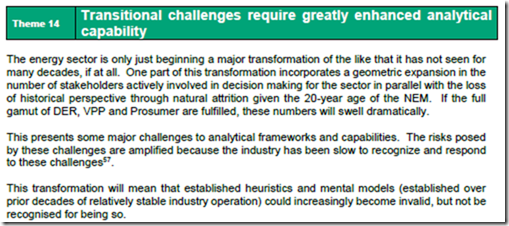Earlier today I wrote here about how the lack of broader* visibility of AGL Energy’s best estimates for the return of Loy Yang A2 (the second time around) was one great example of why the AEMC should proceed with what ERM Power had proposed:
(1) broader visibility* of DUID-level availability in MT PASA would make it clearer for everyone to understand when AGL Energy is currently expecting the unit to be returned; hence
Note here (*) that I speak about broader visibility, as the AEMO already knows what AGL Energy’s best assessment is of the return date is for Loy Yang A2. Indeed, the ERM Power submission (linked below) notes that, in some circumstances, other parties might also know the same thing – however the broader market does not.
(2) with this information, participants in (or other significant stakeholders of) the wholesale market might be much better informed about what this might mean for their own businesses.
Coincidentally today, guest author Allan O’Neil also posted a longer article about the first time the RRO has been called into action – after being triggered by the South Australian Minister of Energy. This action also points at one other example of where what ERM is proposing would really help – more specifically:
(1) there is no MT PASA data published yet for the majority of Q1 2022, and yet now market participants are being explicitly encouraged to enter into hedge contracts for the quarter.
(2) in the absence of supply/demand projections in MT PASA, it seems logical that the task of understanding a “fair” price that matches supply/demand dynamics might be all the more difficult. Unless I am missing something?
Given the coincident articles, and that we had referred to these proposed changes before, I thought it worth a short explicit article to follow on.
(A) What ERM have requested
ERM submitted two separate rule change requests around the same time, and the AEMC wisely chose to assess them at the same time, under the banner “Improving transparency and extending duration of MT PASA”.
| From ERM Power | Proposition |
|---|---|
| Transparency (and Accuracy)
AEMC ERC0270 |
On 29th March 2019, ERM Power submitted this “Medium Term Projected Assessment of Adequacy Transparency and Accuracy Amendments Rule Change Request”, which the AEMC tagged as ERC0270.
There are several facets of what was requested, but the main thrust for me was that ERM asks for unit level availability data to be made available in the published MT PASA data set to the broader market. |
| Additional 12 Month Duration
AEMC ERC0271 |
On 29th March 2019, ERM Power submitted this “Medium Term Projected Assessment of Adequacy 12 Month Extension of Duration Rule Change Request”, which the AEMC tagged as ERC0271.
This requests that the MT PASA time horizon be extended from 24 months (currently) to be 36 months into the future. |
In principle, both of these seemed like very sensible requests – as we noted on 7th August (when considering the outages of Loy Yang A2 and Mortlake 2) and on 15th August (after having a chance to meet with AEMC on the tail end of some commitments for the Generator Report Card 2018 ).
On the AEMC website, submissions by 21 parties are listed.
(B) The AEMC’s draft ruling
On 24th October 2019, the AEMC published this draft determination, broadly supportive of the two rule change requests.
The AEMC noted that their preferable draft rule, would…
provide the market with:
• Generation availability of individual scheduled generating units.
• An extended MT PASA outlook horizon from two to three years.
• A maximum and minimum aggregated scheduled generating availability, adjusted for
forced outage assumptions.
• Transparency of intending generation included as an MT PASA input
• Published actual demand and forecast demand in the same format (‘as generated’).
• A requirement on participants to provide MT PASA inputs that represent their current
intentions and best estimates
In this light we made further comments on the on 18th November (in relation to the ability that would emerge for more people to independently perform their own analysis of generator Forced Outage Rates).
This is something, for instance, that we would like to include in future updates to our Generator Report Card 2018 – not just for coal units, but for all types of plant (which may well require separate attention to publication of a real “technical availability” for Semi-Scheduled plant, before being overlaid by energy constraints to present an “energy-constrained availability” into the NEMDE dispatch process).
That brings me to the two earlier articles today – about the need for DUID-level visibility (in relation to the Loy Yang A2 new outage), and the need for a 36-month time horizon (about the RRO being triggered for Q1 2022).
(C) Submissions on the AEMC’s Drafts
Submissions on the AEMC’s draft ruling were due last week, on Thursday 9th January 2020.
This article could be taken as another note of support for the general direction that this rule change is headed. In our view, it’s one facet of what we wrote about in Theme 14 within Part 2 of our Generator Report Card 2018:
The transitional challenges we’re all grappling with in the NEM require greatly enhanced analytical capability. A core part of this is an expanded data set comprising real information (like what’s being requested here).
—————–
On that note, we’re only 2 weeks away (fingers crossed) from releasing our latest steps in assisting with that “greatly enhanced analytical capability”, with the upcoming release of our first separate Generator Statistical Digest – with 10 years of data to 31st December 2019.



Leave a comment